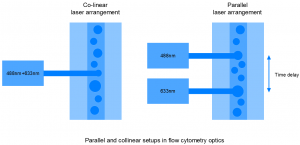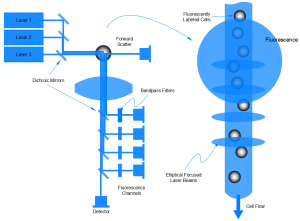In the realm of flow cytometry, where the study of cells hinges on fluorescent tagging and precise optical analysis, optimizing the signal-to-noise ratio (SNR) stands as a paramount objective. This article, the final installment in a trilogy focusing on flow cytometry optics, delves into the critical task of elevating SNR for more accurate data acquisition. Before dissecting strategies for SNR enhancement, let’s revisit the fundamentals of flow cytometry.
Flow cytometry, a cornerstone of cellular analysis, employs fluorescently labeled cells traversing past lasers within a liquid medium. By compelling these cells through an interrogation point in single-file fashion, the technique facilitates meticulous optical scrutiny. Laser configurations, whether collinear or parallel, bathe the sample in excitation light, while detectors capture emitted fluorescence and scatter data.

Elevating SNR in flow cytometry transcends merely amplifying fluorescence signals; it demands mitigating background noise to accentuate pertinent cellular data. This endeavor implicates every facet of the flow cytometry apparatus, alongside experimental parameters and staining methodologies. Key optical components influencing SNR encompass lasers, optical filters, dichroic mirrors, lenses, and detectors.

Laser characteristics wield considerable influence over flow cytometer SNR. Beyond selecting appropriate wavelengths and power, attentiveness to output power stability is imperative. Striving for minimal variations—quantified by peak-to-peak and root mean square measurements—attenuates noise, especially crucial for discerning subtle cellular features. Laser beam quality, gauged by the M² parameter, delineates focusing precision; deviations from ideal diffraction-limited beams entail compromised signal power density and aberrant intensity profiles.
In the pursuit of heightened SNR, meticulous attention to optical components is indispensable. Even with exemplary lasers, subpar filters, mirrors, or lenses can undermine data fidelity. Optimal performance necessitates components manufactured to exacting standards, aligned with the specific requirements of the experimental setup. Notably, filter wavelength ranges must align precisely with fluorophore excitation and emission spectra to obviate inaccuracies and spurious double counting.
In the intricate landscape of flow cytometry, optimizing SNR emerges as a linchpin for extracting meaningful cellular insights amidst the cacophony of background noise. By refining laser performance and ensuring the integrity of optical components, researchers can elevate the fidelity of flow cytometry data, paving the way for deeper comprehension of cellular dynamics and biological processes.
Contact Shanghai Optics today! We’d be more than happy to discuss your projects and how to best bring them to fruition.